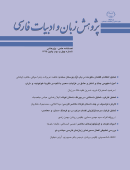کارکرد توصیف در چند داستان کوتاه معاصر فارسی
محورهای موضوعی : پژوهشهای ادبیات کلاسیک ایرانمینا اعلایی 1 , محمد جواد شکریان 2
1 -
2 - دانشگاه اصفهان
کلید واژه: داستان کوتاه روایت توصیف رئالیسم ناتورالیسم,
چکیده مقاله :
همواره در آثار ادبی، توصیف و روایت به شکلی غیرقابل تمایز در هم تنیدهاند. همسو با پژوهش های روایت شناسانه در دهه های اخیر، نظریه های متعددی نیز به ارائه ی الگوهایی از کارکردهای مختلف توصیف در آثار متفاوت پرداخته و به هر یک از انواع ادبی، شکل خاصی از توصیف را نسبت داده اند. در این میان، توصیف در آثار رئالیستی و ناتورالیستی از جایگاه ویژه ای برخوردار و نقش آن در پرداخت رویدادها و شخصیت ها انکارناپذیر است. جستار پیش رو، با هدف تعمیم نظریه های مربوط به توصیف بر چندین داستان رئالیستی و ناتورالیستیِ معاصر فارسی، سعی دارد پس از مطالعه تاریخچه و جایگاه توصیف در رمان، نقش آن را در تعیین چارچوب مکانی-زمانی، رسالت آموزشی و به طور کلی زیبایی شناختیِ چند داستان کوتاه ایرانی تبیین نماید. در این راستا، داستان-هایی از جمالزاده، هدایت، علوی، آل احمد و چوبک را برگزیدیم و کارکردهای گوناگون توصیف را در آن بررسی کردیم: نتایج این تحقیق نشان میدهد که در آثار نویسندگان مذکور، توصیف نه تنها عنصری خنثی و توقفگاه در روند روایت نبوده بلکه از طریق شگردهای استتار آن در روایت، امکان پیشبرد داستان نیز فراهم شده است. علاوه بر تبیین رفتار و کنش شخصیت ها، توصیف در داستان-های مورد مطالعه گاه به آماده سازیِ چارچوب مکانی-زمانیِ داستان میانجامد و گاهی نیز به شکل مجموعه ای از بینش های لغت نامه ای درمی آید و کارکردی آموزشی می یابد.
In literary works, narratives and descriptions have always been interconnected in an indistinguishable way. In accordance with narratological studies during last decades, several theories have presented models of various functions of description in different literary works and ascribed a specific form of description to each of the literary genres. Among these genres, the importance of description in realism and naturalism, and its role in developing the events and characters, is irrefutable. This research, aims at applying the theories an literary description to several realist, and naturalist contemporary Persian stories. After studying the history and importance of description in novels, this research tries to explain its role in defining spatio-temporal framework, and the educational and generally aesthetic goals of several Persian short stories. In this regard, stories from Jamalzadeh, Hedayat, Alavi, Al-e-Ahmad, and Choubak have been selected, and different functions of description in these stories have been investigated. The results of the Research show that in the above mentioned authors’ works, description has not been a neutral element, and it doesn’t put a stop to the narrative process, but it helps the development of the story through different ways of camouflaging it. In addition to expressing the behavior and actions of characters, in the stories studied, description occasionally results in the preparation of spatio- temporal framework of the story, and sometimes it turns into a collection of encyclopedic insights and finds an educational function.
